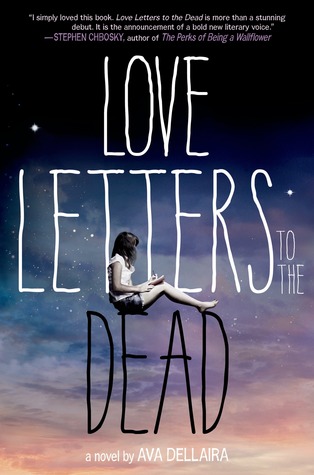In the interest of full disclosure, I should probably tell you that Love Letters to the Dead is not exactly a lesbian book – the main character, Laurel, is definitely interested in boys. But despite its casting of a straight protagonist, Love Letters is a beautiful example of how to write a pair of lady-loving secondary characters, something that is not often done so seamlessly in YA fiction.
On the first day of English class, Laurel is asked to write a letter to someone who has died. She chooses Kurt Cobain, mainly because her recently deceased sister, May, loved him. Laurel never hands in this assignment, but continues to write to Kurt and other famous people who passed tragically. These missives shed light on the complicated lives of these celebrities and allow Laurel to come to terms with May’s death – and to examine her own life, as well.
As part of Laurel’s coping, she decides to transfer to a different high school than the one May attended. At her new school, she meets Natalie and Hannah, a pair who quickly accept Laurel into their circle. Natalie and Hannah are your quintessential high schoolers on the fringes of the social hierarchy, and while they certainly embody a “type” of teenager (one who parties, drinks, sneaks out after dark, and occasionally cuts class), the two do not come across as cliché.
The story of Natalie and Hannah’s more-than-friendship is definitely one of the most compelling parts of the novel. Dellaira has a talent for writing about complicated emotions, and while there was a stark contrast in how the girls chose to show – or hide – their feelings for each other, I thought both were represented well. The complexity of their situation feels genuine, so their confusion resonates with the reader rather than alienating her.
The thing that struck me about the introduction of these two as being in a (deeply problematic) relationship was the flippancy with which Laurel described her reaction. She is certainly alarmed when she discovers her two friends making out, and a combination of alcohol and Natalie and Hannah’s panic at being caught makes Laurel run away. But while witnessing their intimate moment startles her, the concept of Natalie and Hannah’s queerness does not faze Laurel at all.
Although no one speaks about what Laurel witnessed for quite some time, it is understood that she is in on the secret. Laurel never pushes them to discuss it, but when one girl (I won’t say who) sobs upon seeing the other in a potentially harmful relationship with an older guy, Laurel’s first words are: “You love her, huh?” This is both the perfect response in the scenario, and rhetorically brilliant on Dellaira’s part – the first vocalization of her sexuality is about love, rather than about identity.
In this way, Laurel’s approach to Natalie and Hannah’s relationship sets a standard for the reader; as she acknowledges their queerness without ever questioning their feelings for each other, we are also compelled to accept their sexuality. This is a prime example of why we not only need more lesbian leading ladies, but more LGBTQ supporting roles as well – when a teenager picks up this presumably “straight” book and sees Natalie and Hannah’s love through Laurel’s eyes, it normalizes queerness in a way that makes them immediately recognize it as valid.
As I continued reading, I was also pleasantly surprised by how often the ladies appeared in Laurel’s letters. I always expect the conflict between secondary characters to vanish as the main plot climbs, but Natalie and Hannah were woven into the central storyline in a way that prevented them from falling flat. Dellaira masterfully conveys the highs and lows of the girls’ relationship through Laurel’s mature voice and a keen sense of observation.
The epistolary novel is certainly one of the more difficult styles to execute, but Dellaira has a knack for making each letter into a well-crafted vignette. I would certainly recommend Love Letters to the Dead for both its queer-ish-ness and its style – though I would warn that its similarity to The Perks of Being a Wallflower may have you wondering if Dellaira’s production work on the Perks movie translated too far into a female version of Stephen Chbosky’s classic.

